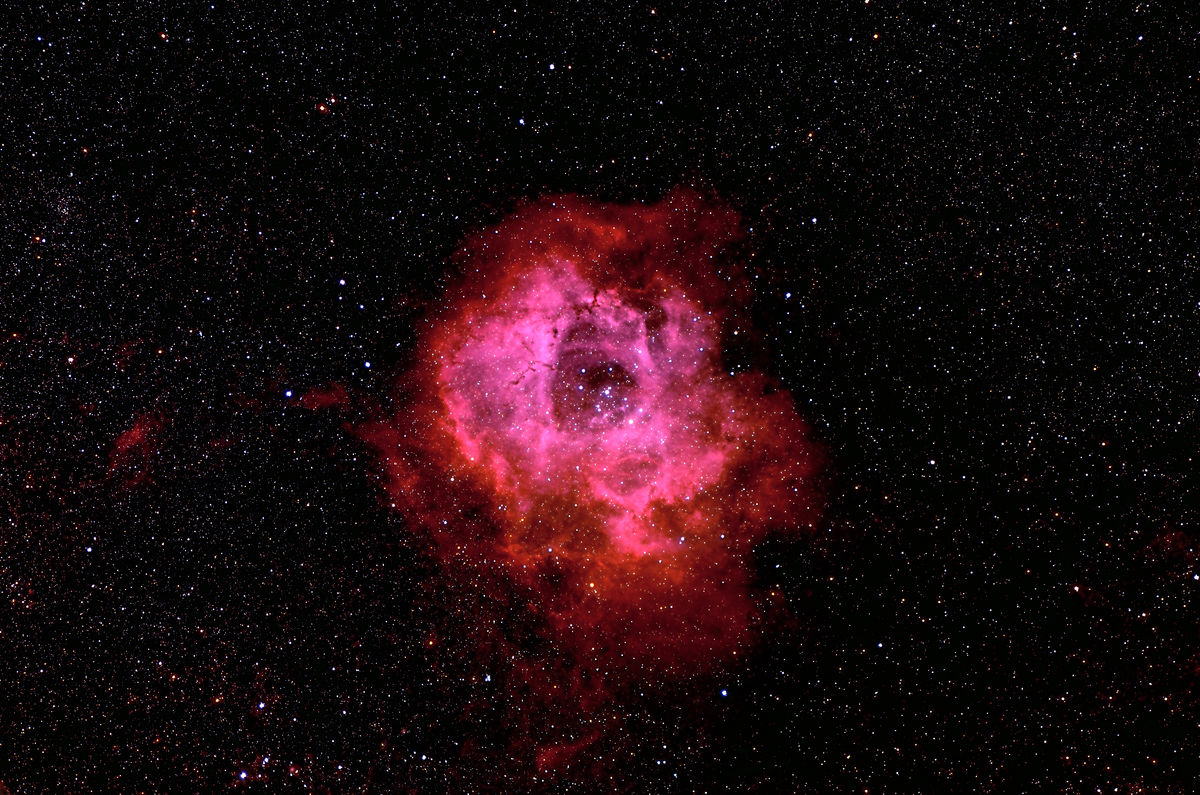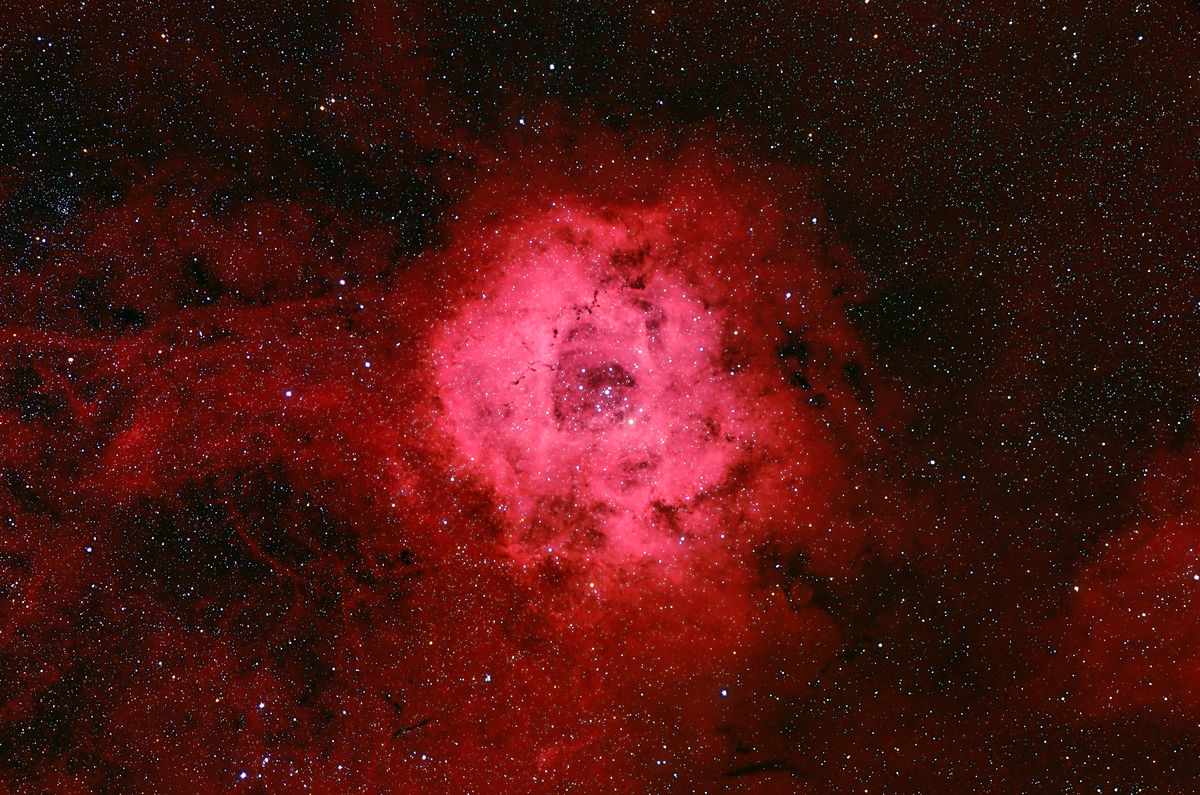Rosette Nebula
Jan 18, 2022 15:01:26 #
Ballard
Loc: Grass Valley, California
Below are two versions of the Rosette Nebula and the cluster NGC 2244 at the nebula's center. The star cluster formed from gas in the nebula. The nebula and cluster are ~5000 light years away in the constellation of Monoceros.
The first image was made using Luminance, Red, Green and Blue filters. The second image substituted a 5 nanometer Narrow Band Hydrogen Alpha filter for the red filter that tends to bring out more of the surrounding nebula (Note: The stars were taken from the LRGB image and added to the second image to keep their color closer to what the eye would see. Both images enhanced the brightness of the nebula relative to the stars as they tended to distract from the nebula). All imaging was done with a 500mm Canon F4.0 lens. If the weather clears up I hope to get some narrow band Oxygen 3 and Sulphur 2 narrow band images within a week or so to create a full narrow band image. All questions comments and suggestions are welcome.
Other imaging details for those interested.
Here is a list of the equipment used
Camera ZWO - ASI6200MM Pro USB 3.0 Cooled Monochrome Camera
Filter wheel ZWO - 7 position filter wheel Used homemade adapter to attach it to the Canon lens.
Filters used Astrodon - Luminance, Red, Green blue and 5 nanometer Narrow band Ha.
Lens Canon Super telephoto 125mm diameter, FL- 500mm F 4.0 lens
Guide scope Explore Scientific APO 127mm diameter FL-950mm F 7.5 .
guide camera Starlight express lodestar X2.
Mount Astro Physics 1600GTO with parallel scope mount to hold the Cannon lens and APO guide scope
64bit ThinkPad laptop running windows 10 pro
Imaging done at a gain of 100 with 1x1 binning at -20C.
20 exposures at 120 seconds for the Luminance filter
20 exposures at 240 seconds for the Red filter
18 exposures at 240 seconds for the Green filter (Lost a couple due to clouds going by).
20 exposures at 240 seconds for the Blue filter
17 exposures at 500 seconds for the HA filter (Lost a couple due to clouds going by).
15 dark frames for each time to create the master dark frame for each time (all at -20C)
30 Flat frames for each filter times used to create the respective master flat frames.
30 Bias frames used to create the master Bias frame.
Software used
Sequence Generator Pro (SG-Pro) Used to take the photo sequence and handle, meridian flip, Plate solving,
drizzel, etc.)
Note: I had to focus by hand with the cannon lens as the telescope focuser I use on my
other scope could not be used on this lens (very limited back focus).
PHD to handle guiding camera and send appropriate control signals to the mount (controlled by SG-Pro)
SKY-X - used to initially point the scope/Cannon Lens to the target
ASI studio - used to initially connect and focus the camera after SKY-X had pointed scope/Cannon Lens
This software was all run on a 64bit ThinkPad laptop running windows 10 pro. Once focus was done the user interface on the ThinkPad was remoted to my Main Desktop computer to control everything from my office.
Image Processing software used and run on a AMD Ryzen Threadripper 2950X 16-Core Processor (3.50 GHz)
Pixinsight - for stacking, noise reduction, stretching, Initial color curve settings, etc.
Digital Photo Professional and Picture window For Minor corrections and cropping and image compression
The first image was made using Luminance, Red, Green and Blue filters. The second image substituted a 5 nanometer Narrow Band Hydrogen Alpha filter for the red filter that tends to bring out more of the surrounding nebula (Note: The stars were taken from the LRGB image and added to the second image to keep their color closer to what the eye would see. Both images enhanced the brightness of the nebula relative to the stars as they tended to distract from the nebula). All imaging was done with a 500mm Canon F4.0 lens. If the weather clears up I hope to get some narrow band Oxygen 3 and Sulphur 2 narrow band images within a week or so to create a full narrow band image. All questions comments and suggestions are welcome.
Other imaging details for those interested.
Here is a list of the equipment used
Camera ZWO - ASI6200MM Pro USB 3.0 Cooled Monochrome Camera
Filter wheel ZWO - 7 position filter wheel Used homemade adapter to attach it to the Canon lens.
Filters used Astrodon - Luminance, Red, Green blue and 5 nanometer Narrow band Ha.
Lens Canon Super telephoto 125mm diameter, FL- 500mm F 4.0 lens
Guide scope Explore Scientific APO 127mm diameter FL-950mm F 7.5 .
guide camera Starlight express lodestar X2.
Mount Astro Physics 1600GTO with parallel scope mount to hold the Cannon lens and APO guide scope
64bit ThinkPad laptop running windows 10 pro
Imaging done at a gain of 100 with 1x1 binning at -20C.
20 exposures at 120 seconds for the Luminance filter
20 exposures at 240 seconds for the Red filter
18 exposures at 240 seconds for the Green filter (Lost a couple due to clouds going by).
20 exposures at 240 seconds for the Blue filter
17 exposures at 500 seconds for the HA filter (Lost a couple due to clouds going by).
15 dark frames for each time to create the master dark frame for each time (all at -20C)
30 Flat frames for each filter times used to create the respective master flat frames.
30 Bias frames used to create the master Bias frame.
Software used
Sequence Generator Pro (SG-Pro) Used to take the photo sequence and handle, meridian flip, Plate solving,
drizzel, etc.)
Note: I had to focus by hand with the cannon lens as the telescope focuser I use on my
other scope could not be used on this lens (very limited back focus).
PHD to handle guiding camera and send appropriate control signals to the mount (controlled by SG-Pro)
SKY-X - used to initially point the scope/Cannon Lens to the target
ASI studio - used to initially connect and focus the camera after SKY-X had pointed scope/Cannon Lens
This software was all run on a 64bit ThinkPad laptop running windows 10 pro. Once focus was done the user interface on the ThinkPad was remoted to my Main Desktop computer to control everything from my office.
Image Processing software used and run on a AMD Ryzen Threadripper 2950X 16-Core Processor (3.50 GHz)
Pixinsight - for stacking, noise reduction, stretching, Initial color curve settings, etc.
Digital Photo Professional and Picture window For Minor corrections and cropping and image compression
LRGB version of the nebula

(Download)
Narrow band HA used in place of Red filter for the red channel.

(Download)
Jan 18, 2022 16:15:20 #
Jan 18, 2022 16:21:47 #
Ballard
Loc: Grass Valley, California
BassmanBruce wrote:
Very nice work. 

Hi BassmanBruce
Thanks for checking out the image of the Rosette nebula and for the comment.
Jan 19, 2022 05:22:10 #
Ballard wrote:
Below are two versions of the Rosette Nebula and t... (show quote)
Very nicely done, well done
Jan 19, 2022 09:26:14 #
Jan 19, 2022 11:13:19 #
Ballard
Loc: Grass Valley, California
Marc G wrote:
Very nicely done, well done
Hi Marc G
Thanks for checking out the image if the Rosette Nebula and for the comment.
Jan 19, 2022 11:16:26 #
Ballard
Loc: Grass Valley, California
alberio wrote:
Wow, that narrow band HA really works.
Hi alberio
Thanks for viewing the Rosette nebula and for the comment. Indeed the Narrow Band HA really brings out the Nebula in this case.
Jan 19, 2022 13:12:32 #
Jan 19, 2022 13:38:53 #
Ballard
Loc: Grass Valley, California
tony85629 wrote:
Very nice. I like the Ha enhanced version.
Hi tony85629
Thanks for checking out the Rosette nebula images and for the comment. Indeed the Ha really helps show the extent of the nebula. I'm certain the whole area would be red with more exposure time.
Jan 19, 2022 14:32:23 #
Ballard wrote:
Below are two versions of the Rosette Nebula and t... (show quote)
The Ha really does grab more of the nebulosity in the region!
bwa
Jan 19, 2022 14:35:17 #
Ballard
Loc: Grass Valley, California
bwana wrote:
The Ha really does grab more of the nebulosity in the region!
bwa
bwa
Hi bwa
Thanks for checking out the shot of the Rosette Nebula and for the comment. The narrow band really brings out nebula regions well. I hope to get O3 and S2 soon to make a full Narrow band image of the Rosette.
Jan 26, 2022 02:34:28 #
Ballard
Loc: Grass Valley, California
For those interested I posted a narrow band image of the Rosette nebula at
https://www.uglyhedgehog.com/t-726797-1.html
https://www.uglyhedgehog.com/t-726797-1.html
Jan 26, 2022 09:47:56 #
That's a pretty Ngc2244 Rosette nebula good job, I tested on it and I can get the core .
Jan 26, 2022 11:06:21 #
Ballard
Loc: Grass Valley, California
stepping beyond wrote:
That's a pretty Ngc2244 Rosette nebula good job, I tested on it and I can get the core .
Hi stepping beyond.
Thanks for the comment. This nebula does have a lot of structure to capture. I really like the loop of gas near the center that stands out in Ha and O3.
If you want to reply, then register here. Registration is free and your account is created instantly, so you can post right away.



